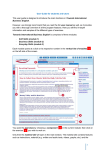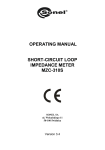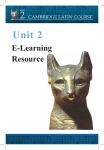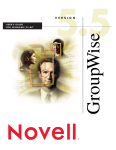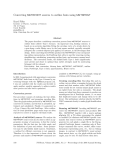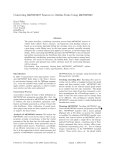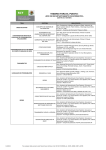Download Praśnaḥ - Aṣṭādhyāyī 2.0 Query Tool (User Manual)
Transcript
Praśnaḥ
Aṣṭādhyāyī 2.0 Query Tool
USER MANUAL
PREFACE
PREREQUISITES
USER INTERFACE
CONDUCTING A SEARCH
THE QUERY LANGUAGE
APPENDIX: QUICK REFERENCE
PREFACE
Aṣṭādhyāyī 2.0 is a digital, interactive and searchable edition of Aṣṭādhyāyī, the famous treatise about
Sanskrit morphology, syntax and semantics, written in the 4th century BCE by the ancient Indian
grammarian Pāṇini. The search feature of Aṣṭādhyāyī 2.0 is provided by Praśnaḥ (English: question or
inquiry), a dedicated web application, that is also referred to as “query tool” in this document. Praśnaḥ
provides a lightweight and powerful query language to search for sūtras and its translations as well as
grammatical attributes such as case, number and gender of their textual components. In addition, the
query tool can be used to search for linguistic annotations such as word-semantic meanings, topics,
lexemes and, moreover, to ascertain whether components are declinable. Queries on textual components
can also be expanded to include anuvṛtti. The query language used by the Aṣṭādhyāyī 2.0 Query Tool allows
to perform queries by the use of predefined query terms, logical operators, wildcards, parentheses,
transliterations as well as special operators to specify component or non-component based searches. The
latter two can also be linked by the use of logical operators and can be weighted by means of bracketing.
This manual highlights all features of the Aṣṭādhyāyī 2.0 Query Tool and helps to understand the key
principles of the query language. In addition, sample searches and hints are given throughout for a
successful learning experience. Be advised that this manual does not include the complete language
reference. Hence you are encouraged to refer to the quick reference provided on the Aṣṭādhyāyī 2.0
website.
PREREQUISITES
The Aṣṭādhyāyī 2.0 Query Tool uses HTML5 and CSS3 technology and should therefore support a broad
range of commonly used web browsers. For best user experience we recommend using a web browser
which has been tested for compatibility and performance with our web application such as the latest
versions of Firefox, Google Chrome and Safari. Also note that the query tool requires a display resolution of
at least 1280 by 1024 to be fully functional. However for a better perception of the query tool, it is strongly
recommended to have a higher resolution such as 1400 by 1050. Be advised that in order to use the
DOC 013_020715-UM
PAGE 1
BUILD 113-09032015-N
Aṣṭādhyāyī 2.0 Query Tool, it is absolutely necessary that your browser has JavaScript and Cookies enabled.
In case these are disabled due to privacy concerns, the upshot will be that the web application refuses to
work and will output an error message (Fig.1) (Fig. 2).
NOTE: JavaScript and Cookies are solely used to enhance usability and to provide extended features
without sacrificing privacy at any time.
USER INTERFACE
The user interface of the Aṣṭādhyāyī 2.0 Query Tool follows a minimalistic design approach to emphasize on
usability. Hence the interface has been divided into three sections which are explained below.
Navigation Bar
The horizontal navigation bar at the top of the screen allows quickly switching to different parts of the
Aṣṭādhyāyī 2.0 website (Fig. 3).
Side Panel
The side panel on the left of the horizontal bar shows the current version of the Aṣṭādhyāyī 2.0 Query Tool
and indicates the user’s unique identification code1. It furthermore provides the latest release notes
accommodating new features as well as contemporary issues (Fig. 4).
Additionally, the side panel has a toggle to cycle through a set of predefined color schemes (Fig. 5), allowing
the user to set a color which achieves the best possible screen reproduction.
Query Panel
The query panel on the right of the horizontal bar is the actual search feature of Aṣṭādhyāyī 2.0. The panel
consists of three boxes, whereas the sole purpose of the top or about box is to provide a brief description
of the Aṣṭādhyāyī 2.0 Query Tool (Fig. 5).
Right below the about box is the query box which allows users to type in or rephrase their queries. The
query box contains a toggle labeled “Example” which can be left clicked to cycle through a list of predefined
sample searches (Fig.6).
Beneath the query box are four buttons labeled “submit query”, “clear query”, “anuvrtti” and “show
help”(from left to right) (Fig. 7), which are described later. The information box (Fig. 8) at the very bottom
notifies the user in case of an error or malformed query with a corresponding message.
CONDUCTING A SEARCH
In order to conduct a search the user has to navigate to the Aṣṭādhyāyī 2.0 Query Tool by left-clicking the
“search” button on the navigation bar at the top of the screen. Once the Aṣṭādhyāyī 2.0 Query Tool is
loaded the caret can be revealed and placed into its position by clicking anywhere inside the query box.
Assuming that the user has not previously used the Aṣṭādhyāyī 2.0 Query Tool the query box will be empty.
1
The purpose of the unique identification code is explained in detail on the next page.
DOC 013_020715-UM
PAGE 2
BUILD 113-09032015-N
HINT: Clicking the “Example” toggle will cycle through a list of predefined queries which can be used as a
template to conduct a new query expression.
Otherwise the box will reveal the user’s last query which can then be rephrased. In order to start a new
search from scratch, it is recommended to clear the query box by simply clicking on the “clear query”
button. Once the query has been conducted or rephrased, the search can be performed by clicking the
“submit query” button. To search for anuvṛtti you need to make sure that anuvṛtti has been enabled by
clicking on the anuvṛtti button.
HINT: Instead of clicking the “submit query” button to run a search, the user can also press the CTRL and
ENTER key simultaneously. This might be a great time saver when running multiple searches or rephrasing
specific query expressions.
Once a search has been submitted the user will be redirected to the Aṣṭādhyāyī 2.0 Browser which will
display the results and number of hits. In order to rephrase the previous query the user may click on the
“search” button on the navigation bar which will redirect him to the Aṣṭādhyāyī 2.0 Query Tool. This
procedure can be repeated until the user obtains the results he expects.
HINT: After submitting a search it’s very easy to switch back and forth between the search results and the
Aṣṭādhyāyī 2.0 Query Tool by pressing the backspace key. This keyboard shortcut is supposed to work in
all major web browsers.
In order to improve the readability of query expressions it’s possible to add line breaks by pressing the
ENTER or RETURN key. Note that the query box uses line wraps, which will automatically places statements
on a new line before they reach the end of the query box. A line wrap however must not be confused with
intentional line breaks.
HINT: Comments may be used to increase the readability or to add notes to query expressions by using
the pound key. Everything from the pound to the end of the line is regarded as a comment and thus being
ignored by the query tool’s interpreter.
For the sake of functionality, the user’s previous query is stored in our database. In order to link a query to
a specific user, the Aṣṭādhyāyī 2.0 Query Tool makes use of a unique identification string which is stored on
the user’s computer as well as in our database. Note that once the user clears the browser cache the
Aṣṭādhyāyī 2.0 Query Tool can no more display the user’s last query expression. Additionally it may also be
worth knowing that the user’s last query has a validity of 24 hours after which it will be automatically
deleted.
In order to use the Aṣṭādhyāyī 2.0 Query Tool to its full potential you should continue reading on the
following section, which will explain everything you need to know about the query language.
THE QUERY LANGUAGE
The Aṣṭādhyāyī 2.0 Query Tool provides a lightweight and powerful query language to conduct searches. In
order to successfully formulate queries, it is essential to have a good understanding of the query language
itself. The query language is subdivided into several language elements or topics for that matter, including
DOC 013_020715-UM
PAGE 3
BUILD 113-09032015-N
query terms, logical operators, order of operations, pattern matching, transliterations, non-component
searches and search restrictions which are described in detail in the following paragraphs.
However, before starting out it is imperative to emphasize the meaning of sūtras, components as well as
linguistically annotations in the context of to the Aṣṭādhyāyī 2.0 Query Tool. A sūtra denotes a distinct type
of literary composition written in one single line, which is made up of words to which we will hereinafter
refer to as components. These components have grammatical attributes (i.e. case, number, gender) which
can be searched for in a regular or non-component based search, respectively. The results will be one or
more sūtras each containing components whose attributes matched the query expression.
Query Terms
The Aṣṭādhyāyī 2.0 Query Tool uses predefined query terms for searching Aṣṭādhyāyī 2.0. Each of these
query terms denotes a specific field of search and can be used repeatedly in a query expression. Even
though query terms and logical operators are case-insensitive, it is generally advised to use capital letters
for both to emphasize readability of complex query expressions. Also note that all query terms are meant
to search for component’s attributes except for the terms “SUTRA” and “TRANS”. The latter two are solely
used for searching sūtras and its corresponding translations.
A query term has consistently to be followed by its value which must be surrounded by parentheses. For
better readability though, one may use whitespaces or even line breaks in-between query terms and
values. Also note that when using the query terms “CAS”, “GEN”, “GRAM” or “NUM” you must choose one
of their predefined values and write them in lowercase letters. Furthermore, it is worth knowing that
certain query terms and values offer alternative spellings.
A common query might be the search for sūtras to which one or more components have a certain
grammatical declension. For example searching for sūtras for which there are components having either
feminine, singular or nominative form, you would use the expression: “GEN (fem) AND NUM (sg) AND CAS
(nom)”.
Here the query term “GEN” defines the grammatical gender to be feminine whereas the query term “NUM”
defines the grammatical number to be singular and “CAS” finally defines the component to be written in
nominative case. Note that all three terms are linked with the logical “AND” operator to force the search
for sūtras containing components where each of them has to meet at least one of those three grammatical
attributes mentioned before. Another useful query might be the search for sūtras containing one or more
components which are compositions or indeclinable, by using the expression: “GRAM (comp) OR GRAM
(indecl)”.
Searching for the semantically meaning and lexeme in components can be achieved by using the query
terms “MEAN” and “LEX”, whereas the search for sūtras and its translations itself is being accomplished by
using the terms “SUTRA” and “TRANS”, respectively. It is important to understand that the form always
remains the same, irrespective of the query terms actually being used. For a complete list of query terms
and predefined values you’re encourage to have a look at the quick reference.
Logical Operators
In all cases where query expressions have been composed with more than one term or compound
expression, it is necessary to link those using logical operators. For that matter the Aṣṭādhyāyī 2.0 Query
DOC 013_020715-UM
PAGE 4
BUILD 113-09032015-N
Tool supports the three commonly used operators “AND”, “OR” and “NOT” to indicate conjunctions,
disjunctions or negations, respectively. All of them can be combined in one single or compound expression
repeatedly.
NOTE: Logical operators are also case-insensitive but it is advised to use capital letters to improve
readability of your query expressions.
A logical conjunction is denoted by the “AND” operator and may only return a search result if and only if
either query term(s) or compound expression(s) are true. For instance the expression “CAS (nom) AND GEN
(f)” will only return sūtras containing one or more components of which at least one has the grammatical
case in nominative form and one (eventually the same) the grammatical gender in feminine form.
A logical disjunction however, which is denoted by the “OR” operator returns a search result only if either
or both query term(s) or compound expression(s) are true. This means that the expression “CAS (num) OR
GEN (f)” for instance, will return sūtras containing one or more components of which at least one has the
grammatical case in nominative form or sūtras containing one or more components having a the
grammatical gender in feminine form.
NOTE: Whenever you use both logical operators “AND” and “OR” you need to specify the precedence of
operation (see next paragraph).
In order to negate values you have to use the “NOT” operator which has to precede any query term and
value that should be excluded from search.
NOTE: The “NOT” operator may not precede compound expressions but instead has to precede any query
term whose value(s) you may like to negate. Also be advised that query expressions may not begin with a
logical operator after all.
Order of Operations
Brackets are used to specify the order of operations of query terms and are a decisive factor when
conducting queries. The Aṣṭādhyāyī 2.0 Query Tool uses two different kinds of parentheses. At the first
level square brackets “*+“ are used to enclose two or more statements, as with the expression “CAS (num)
OR * GEN (f) AND NUM (sg) +”. Since square brackets may not be nested the user has to use curly braces “,-”
at the second level of bracketing such as “CAS (acc) OR , CAS (num) OR * GEN (f) AND NUM (sg) + -”. Be
advised that bracketing of nested or compound expressions is not allowed. Also note that component
based searches may use the same bracketing and are not regarded as nested expressions.
NOTE: When using the “AND” and “OR” operators in your expression you must always specify the order of
operation.
Pattern Matching
The Aṣṭādhyāyī 2.0 Query Tool allows the use of the wildcard characters “*” and “?” to pattern matching
values. Both wildcards can be placed at any point within a query term’s value. Note that the asterisks
“*”matches any character one or more times whereas the question mark “?” matches a single character
only once.
DOC 013_020715-UM
PAGE 5
BUILD 113-09032015-N
NOTE: The query terms „SUTRA“ and „TRANS“ both use the asterisk pattern character at the beginning
and end of your search strings, to match any sūtra or translation in which the given search term appears.
Transliterations
Since sūtras in Sanskrit are written in the Devanagari script, the Aṣṭādhyāyī 2.0 Query Tool allows the use of
transliteration, which in regard to Aṣṭādhyāyī 2.0, is the conversion of Roman script to Devanagari. The
transliteration can be achieved by the use of Velthuis and may only be used in conjunction with the query
terms “SUTRA”, “MEAN”, “TRANS” and “LEX”. Also note that transliterations must be all written in
lowercase and be surrounded by forward slashes “/ /”. A short example to illustrate the use of
transliteration would be the expression “SUTRA (*/aa/*)”, which searches for sūtras containing the short
vowel “अ“ in Devanagari script. However for a complete list of transliterations you are strongly encouraged
to read the quick reference.
Component Searches
When using the Aṣṭādhyāyī 2.0 Query Tool, searches are usually based on linguistic attributes of spanned
components. However when searching for sūtras and translations you may conduct a strict component
based search by surrounding the expression with right and left angle brackets “< >”, as in “<LEX (kart/.r/)
AND CAS (loc) >”. The query shows all sūtras in which the Sanskrit term for agent “(kart/.r/)” is mentioned
in locative case. Whereas in a regular or spanned component search one would conduct a query like “LEX
(kart/.r/) AND CAS (loc)”, which would search for all sūtras in which the Sanskrit term for agent “(kart/.r/)”
is mentioned and where a component (possibly different from “(kart/.r/)”) is in locative case.
NOTE: Component and non-component based searches can be linked using logical operators. Additionally
a non-component based search may use all kinds of bracketing irrespective of bracketing used by the
outer expression.
Search Restrictions
The Aṣṭādhyāyī 2.0 Query Tool allows you to narrow down your search on sūtras or components from a
certain book and chapter of Aṣṭādhyāyī. This means you can specify a range of sūtras in which to search in
and might come in handy in case that you already know in what sūtras or components you’re actually
interested in. The special operator needed is “SNR” and can denote up to five ranges which have to be
separated by a semi-colon.
NOTE: The “SNR” search restriction may only be used once per query and effects the entire expression.
For instance when searching for sūtras for which there are components having either feminine, singular or
nominative form only in the first and second book, you would use the expression: “[ GEN (fem) AND NUM
(sg) AND CAS (nom) ] and SNR (1-2)”. This query terms can be negated with the “NOT” operator one could
also conduct the same query using the expression: “[ GEN (fem) AND NUM (sg) AND CAS (nom) ] and NOT
SNR (3-8)”. Be advised that when searching within one specific book the user still has denote it as a range
(i.e. SNR (1-1)). Searching in two chapters from the same book can be achieved by specifying ranges, as in
“SNR (1.2-1.2;1.4-1.4)”. Here the search would be conducted only on Chapter two and four from the first
book of Aṣṭādhyāyī.
DOC 013_020715-UM
PAGE 6
BUILD 113-09032015-N
APPENDIX: QUICK REFERENCE
This quick reference provides a summary of query terms, search operators and transliterations used by the
Aṣṭādhyāyī 2.0 Query Tool.
QUERY TERMS
Query Term
cas
Alt. Spelling
casus
case
Search Type
component
Short Description
grammatical case
gen
genus
gender
component
grammatical gender
gram
grammar
component
grammatical type
lex
mean
lexeme
meaning
sem
semantic
numerus
number
translation
component
component
lexeme
semantic
component
grammatical number
sutra
component
sutra
sutra
topic
Translation
num
sutra3
topic
trans
Value(s) / Alt. Spell.
nom; nominative
gen; genitive
loc; locative
abl; ablative
acc; accusative
dat; dative
voc; vocative
m; masculine
f; feminine
n; neuter
comp; composition
decl; declined
indecl; undeclined
*2
*
Example(s)
cas(nom)
sg; singular
du; dualis pl; plural
*
*
*
num(sg)
gen(f)
gram(decl)
lex(nose)
mean(nose)
sutra(ion)
trans(nose)
SEARCH OPERATORS
Operator
and
Short Description
logical conjunction resulting in true if both of its
operands are true, otherwise the value is false
Value(s)
-
or
logical disjunction resulting in true if one or both
operands are true, otherwise the value is false
-
Operator
not
snr
Short Description
negates the result of the following query term
specifies the range of books, chapters and sutras to
search in
Value(s)
x-x
x.x-x.x
Example(s)
cas(nom)
and
gen(f)
num(sg)
or
trans
(mean)
Examples(s)
not gram(decl)
snr(1-4)
snr(1.3.3-2)
2
Values marked with an asterisk may be arbitrary.
The query terms „sutra” and „trans“ both use the asterisk character by default to match any sutra or translation in
which the given search term appears.
3
DOC 013_020715-UM
PAGE 7
BUILD 113-09032015-N
*
?
<>
matches any character one or more times
matches a single character one time
indicates a component based search
x.x.x-x.x.x
-
()
[]
parentheses enclose values
square brackets enclose multiple expressions
-
{}
curly brackets enclose expressions in brackets
-
snr(1.2-1.4;4-5)
mean(nos*)
mean(n?se)
< mean (nose)
and
gen (n) >
sutra(ion)
cas(nom) and
[ gen(f) or gen(n) ]
{ cas(nom) and
[ gen(f) or gen(n) ] }
or num(du)
TRANSLITERATIONS
Operator
//
Operator
Description
forward slashes enclose
transliterations
Description
DOC 013_020715-UM
Velthuis
a
IAST
a
Devanagari
aa
ā
आ
i
i
इ
ii
ī
ई
u
u
उ
uu
ū
ऊ
.r
ṛ
ऋ
.rr
ṝ
क
.l
ḷ
ऌḷ
.ll
ḹ
खḹ
e
e
ए
ai
ai
ऐ
o
o
ओ
au
au
औ
.m
ṃ
अ
.h
ḥ
अ
Velthuis
~
IAST
‘
Devanagari
ka
ka
क
kha
kha
ख
ga
ga
ग
gha
gha
घ
“na
ṅa
ङ
ca
ca
च
cha
cha
छ
ja
ja
ज
PAGE 8
अ
Example(s)
sutra(/.rr/)
sutra(e/.d/ion)
sutra(i/.l/io/~n/)
Example(s)
ऽ
BUILD 113-09032015-N
DOC 013_020715-UM
jha
jha
झ
~na
ña
ञ
.ta
ṭa
ट
.tha
ṭha
ठ
.da
ḍa
ड
.dha
ḍha
ढ
.na
ṇa
ण
ta
ta
त
tha
tha
थ
da
da
द
dha
dha
ध
na
na
न
pa
pa
ऩ
pha
pha
प
ba
ba
फ
bha
bha
ब
ma
ma
भ
ya
ya
म
ra
ra
य
la
la
र
va
va
व
“sa
śa
श
.sa
ṣa
ष
sa
sa
स
ha
ha
ह
PAGE 9
BUILD 113-09032015-N










